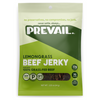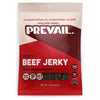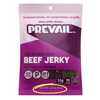How Is Top 8 Allergy-Free Beef Jerky Made?

What in tarnation is top 8 allergy-free beef jerky?
Well, to cut to the chase, it’s all-natural jerky: the way jerky’s meant to be.
What makes jerky NOT allergy free are the seasonings and marinades that are added, so if you replace those ingredients with healthy substitutes (like coconut aminos), you’ve got yourself some safe-to-eat, delicious beef jerky!
So, want to know how it’s made? Just read the 3 steps below!
What makes beef jerky allergy free?
If you have any food allergy, you know the struggle to find — out of all things — beef jerky that’s safe to eat.
And even if it’s just meat (allegedly), most beef jerky brands add in ingredients that are terrible for people with food allergies.
Soy sauce, cane sugar, and gluten can all kickoff allergies and are present in most beef jerky brands for flavoring or to preserve the food.
The best allergy-free beef jerky is seasoned with organic spices, and other safe ingredients to make sure they don’t cause any allergies.

Check out allergy-free beef jerky with lemongrass, spicy or umami flavor!
How Is Allergy-Free Beef Jerky Made: 3 Steps
Want to learn how allergy-free beef jerky is made?
Read below to find out how: from the cow grazing all the way to the supermarket shelf!
#1 From the grasslands…
All cows live on the field. But not all cows eat grass during their lifespan.
To cut costs, most farmers feed their cows with soybeans: it fattens them up quickly and requires less land mass than natural grass grazing.
And while allergy-free beef jerky doesn’t have to be 100% grass-fed and grass-finished, PREVAIL Jerky is.
100% grass-fed beef jerky means that the cow ate grass throughout its entire life. Not only was the cow healthier during its lifespan, but a grass diet also adds more flavor and protein to the beef jerky.
Regular, soy-fed cows build up fat which means the beef jerky is fatty too. Also, since soybeans aren’t natural for cows to eat, farmers give them antibiotics and hormones to counterattack infections that arise from a soy diet.
#2 The cut and marination of the beef
To make proper jerky, you need to cut against the grain.
What’s the grain, you ask? Its ridges on the beef, which mark the muscle fibers. You need to cut against them to make sure the beef jerky stays tender, not chewy.
Then, once the beef’s been sliced, it has to be marinated for around 3 hours or overnight.
Most beef jerky is marinated in soy sauce, which can cause food allergies. PREVAIL Jerky is allergy-free and marinated with coconut aminos and other organic spices, making it safe for everyone to eat.
#3 The cooking
Once the beef has been marinated to gain a spectacular flavor, it’s time to make it into proper beef jerky!
The slices of beef go right into the smoker grill and cook over a rack for around 4 hours to become tender and delicious.
Then, to make the final touches, the beef is cut up into pieces that are a perfect snack.
Yum! That’s the story of beef jerky, short and sweet — just like it’s meant to be!
What Is the Nutritional Value of Allergy-Free Beef Jerky?
A serving of top 8 allergy-free beef jerky packs 12g of protein, making it the perfect snack for your workouts.
And it’s rich in iron (6% of the required daily intake) and vitamin C (2%), which makes it a healthy snack for your kids to eat after a sporting activity.
PREVAIL top 8 allergy-free jerky is also paleo, gluten-free and keto certified, making it an ideal snack for anybody following these diets.
So, if you want a nutritional, protein-rich snack for whenever you’re on the go, at the gym, or just plain hangry, check out PREVAIL Jerky.











